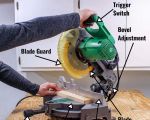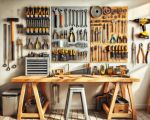
May 17, 2025
Table Saw Safety Tips for DIYers: A Comprehensive Guide
As a DIY enthusiast, there’s nothing more satisfying than creating something with your own two hands. Whether you're building a bookshelf, a new desk, or a custom frame, having the right tools is crucial. One of the most important tools in your woodworking arsenal is the table saw. It’s a powerful machine that can make precise cuts, but it also comes with its own set of safety concerns. Over the years, I’ve learned the importance of practicing proper safety measures to avoid accidents and ensure a successful project. Here are the top table saw safety tips for DIYers like you and me.
1. Always Wear Proper Safety Gear
Before you even turn on your table saw, the first step in ensuring safety is putting on the right safety gear. Safety glasses are a must, as flying wood particles can easily get into your eyes. For added protection, you should wear ear protection to shield your ears from the loud noise that the table saw generates. Finally, make sure you're wearing tight-fitting clothing and avoid any loose sleeves, as they can get caught in the machine.
2. Familiarize Yourself with the Table Saw
If you’re using a table saw for the first time, or even if you’ve been using it for years, it’s crucial to familiarize yourself with the different parts and functions of the saw. Understanding how the blade functions, how to adjust the fence, and how to align the blade with your cut will make a huge difference in both safety and accuracy. Read the manual thoroughly before using the saw, and if you’re unsure about any part of the process, don’t hesitate to ask for advice or watch a tutorial.
3. Use a Push Stick or Push Block
Never, ever, push wood towards the saw blade with your hands. Even though the blade is designed to cut through the material, it’s still easy to accidentally slip and get your hands too close to the blade. Using a push stick or push block allows you to guide the material safely while keeping your hands at a safe distance. This simple tool can be a lifesaver in preventing cuts and injuries.
4. Keep the Saw Blade Guard in Place
I understand that some DIYers remove the blade guard to make their cuts easier, but this is one of the biggest mistakes you can make. The blade guard is there for a reason – it protects your fingers and hands from the rotating blade. Always make sure the blade guard is securely in place before using your table saw. If your saw doesn’t come with a blade guard, consider investing in an aftermarket one.
5. Make Sure the Blade is Properly Aligned
An out-of-alignment blade can lead to inaccurate cuts and can be dangerous. Before starting a project, always double-check that your table saw’s blade is aligned properly. Most table saws have an alignment feature built in, but if you're unsure, it’s worth checking with a square or calibration tool. A misaligned blade not only reduces the quality of your work but increases the chances of a kickback.
6. Avoid Rip Cuts Without a Fence
When performing rip cuts (cutting wood along its length), it’s essential to use the rip fence to guide the material through the saw. Without the fence, the wood can easily shift or bind, which can lead to dangerous kickbacks. If your table saw doesn’t have a reliable rip fence, consider upgrading to a better one for better control and safety.
7. Never Cut Small Pieces of Wood
Cutting small pieces of wood with a table saw can be incredibly dangerous. Small pieces can easily be kicked back towards you with extreme force. Always use a jigsaw or another appropriate tool for cutting small pieces. If you must cut small pieces with the table saw, always use a push stick and keep a safe distance from the blade.
8. Keep the Table Saw Clean and Well-Maintained
Regular maintenance is key to keeping your table saw running smoothly and safely. Dust and debris can accumulate on the surface, making it harder to control your materials and even increasing the risk of a fire. Clean your table saw after every use, and periodically check for any signs of wear, such as a dull blade or loose parts. If you notice any issues, take the time to fix them before using the saw again.
9. Stand in the Right Position
It’s easy to overlook body positioning when using power tools, but your stance plays a huge role in your safety. Always stand to the side of the saw, not directly in line with the blade. This minimizes the risk of injury in case of a kickback. Your body should be positioned in such a way that you have control over the material and can easily make adjustments as needed.
10. Never Leave the Table Saw Running Unattended
It might sound like common sense, but it’s important to emphasize: never leave your table saw running unattended. Accidents can happen in a split second, and you want to be in control of the saw at all times. If you need to step away, turn the saw off and ensure the blade has come to a complete stop before leaving the workspace.
Final Thoughts
Using a table saw can be incredibly rewarding, as it allows you to create detailed and professional-looking woodworking projects. However, with its power comes responsibility. By following these table saw safety tips, you can ensure that you’re working safely while achieving your DIY goals. Always remember that safety comes first, and don't hesitate to invest in additional safety tools and equipment to protect yourself and those around you.








